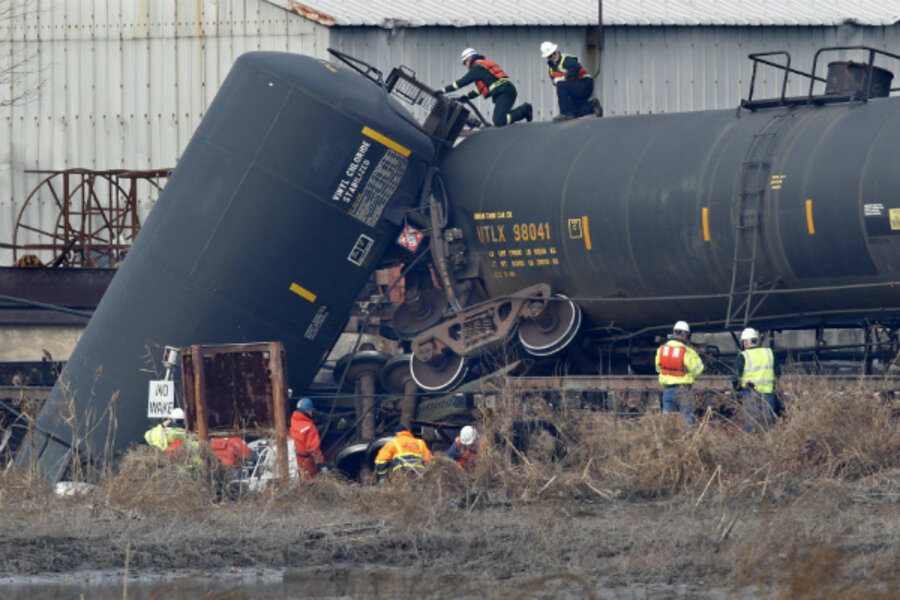New Jersey derailment: How safe are hazmat rail shipments?
A derailment that caused a spill of toxic and highly flammable gas from at least one of several tank cars that toppled off a New Jersey bridge and into a creek, has raised concerns about rail shipments of hazardous chemicals through the nation's cities and highly populated areas.
In the immediate aftermath, New Jersey authorities blamed a bridge failure for sending seven train cars plunging into Mantua Creek, according local news reports. At least four of the tank cars containing toxic vinyl chloride fell from the collapsed bridge into the creek, the South Jersey Times reported.
Just one of the cars leaked vinyl chloride, which eventually dissipated into the air, state officials told the Associated Press. But some 20 people were reportedly affected by the vapor from the wreck with nearby residents evacuated and schools locked down.
It was a sharp reminder of years gone by, when the threat of tank cars carrying toxic chemicals through urban communities was a top concern.
After 9/11, federal authorities and Congress highlighted the threat from rail cars carrying chlorine, ammonia, other toxic gases, as well as explosives, traveling through densely populated areas. The Federal Bureau of Investigation in 2002 warned that Al Qaeda might be planning to attack US trains, either to derail them or to blow up hazardous material-laden tank cars.
The cause was also joined by environmental groups and activists who, among other things, famously photographed a tank car carrying chlorine with the nation's Capitol building in the background. That began a push to get such shipments detoured around metropolitan areas and heavily populated areas.
A handful of major accidents, including a 2001 freight train derailment near Minot, N.D., drove home the activists' point. In that case, five tank cars carrying ammonia gas broke open, releasing toxic fumes that killed one and injured 1,441, federal data show. In 2005, a train collision in Graniteville, S.C., broke open one tank car loaded with 90 tons of chlorine, releasing about two-thirds of the gas. Nine died and 252 were injured.
Following the North Dakota accident, the National Transportation Safety Board (NTSB) in a 2004 study concluded that more than half of the 60,000 rail tank cars used to transport hazardous materials at that time were not built according to standards and were susceptible to rupture in the case of an accident.
Overall, there were 310 rail accidents involving hazardous-materials spills during the past decade, Federal Railroad Administration rail-accident data show. Among those, 31 of the accidents resulted in 22 deaths and 1,926 injuries. In the other 90 percent of such accidents, no one was harmed. Over the five-year period from 2007 to 2011, such hazmat-rail accidents fell to an average of 26 per year, down 17 percent from the previous five-year period. In 2011, there were 20 such accidents, with 17 so far this year.
"We have been seeing a positive trend in this area," says Holly Arthur, a spokesman for the Association of American Railroads (AAR), which represents major railroads. "Today 99.97 percent of hazmat-rail shipments reach destination without a release."
Rail accidents with hazmat releases have fallen 83 percent since 1980 and 43 percent since 2000, an AAR analysis of the federal data shows.
But in New Jersey, the derailment had local activists saying the threat remains.
“We need more oversight and we need to put in place programs to make our trains safer and less vulnerable to spills,” Jeff Tittel director of the New Jersey Sierra Club told the South Jersey Times. "We need to do a better job maintaining our rail lines to prevent derailments. For far too long, the railroads have been able to avoid making their trains safer and those loopholes need to be closed."
More information is needed, he and others said, on just what types of chemicals are being transported. Congressional legislation to mandate the rerouting of hazardous materials around major population areas failed in 2007, notes Fred Millar, a rail-security consultant.
"We have today a federal law that basically says the railroad industry can make their decisions about shipping these hazardous materials in complete secrecy and not tell anyone," he says. "What it means is that American citizens really do not know today whether railroads are actually protecting major cities by rerouting these shipments."
A senior railroad industry official, who spoke only on condition of anonymity because he was not permitted to speak publicly on the matter, noted that the industry does indicate the types of shipments to local emergency officials to give them a heads up, but not the timing of the shipments passing for security reasons.
Sen. Frank Lautenberg (D) of New Jersey said in a statement that he is working with the NTSB and other federal agencies to investigate the accident.
“Safety is the highest priority along our railways, and this incident requires a thorough investigation into the cause of the accident and any impact on the environment in the surrounding areas,” said Senator Lautenberg, chair of the Commerce Surface Transportation Subcommittee, which has jurisdiction over rail safety. “Railways are essential to New Jersey's economy and we must further investigate this incident to make sure they are operated as safely as possible when they pass through our communities.”






